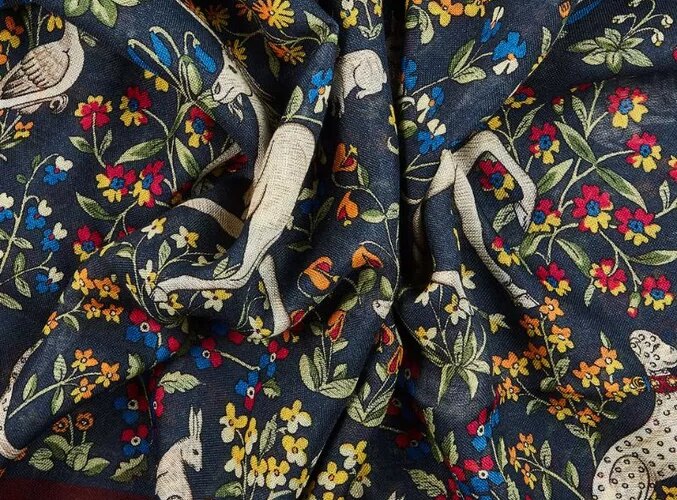There are still many consumers unfamiliar with Jacquard fabric. However, bedding factories and fabric stores are already familiar with it. Jacquard fabric is a type of material used in everyday life. Let’s explore its applications together. Find the answers in the article below by Fashion Bandung.
What does Jacquard fabric refer to and how many variations of it exist?
The concept of Jacquard fabric has piqued the interest of many consumers. Essentially, Jacquard fabric is a type of woven textile that showcases intricate patterns and designs. What makes Jacquard fabric unique is that these patterns are not added through printing or hand embroidery; instead, they are directly woven into the fabric structure by the skilled hands of the weaver. This weaving technique creates a visually stunning and highly detailed fabric. Jacquard fabric is commonly used in various home furnishings like curtains, cushions, carpets, and bedding. Its presence can easily be spotted in these household items, adding an elegant touch to any interior space.
In the past, Jacquard fabric was primarily made from silk. However, in modern times, this type of fabric is also produced using various other fibers such as silk, cotton, PE synthetic fibers, cotton, or polyester jacquard fabric. One notable characteristic of this fabric is that it is usually thicker compared to other fabrics.
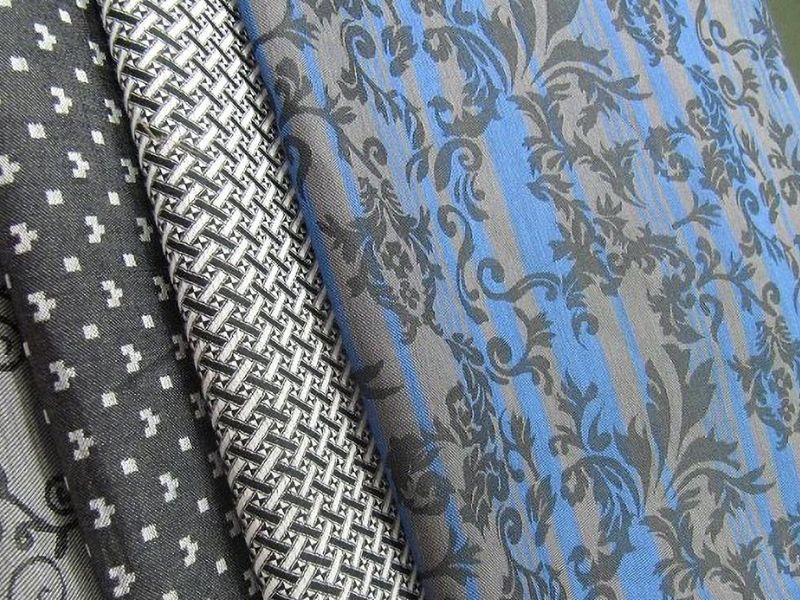
Jacquard fabric is a type of fabric that is characterized by intricate patterns or designs woven into it. It is created using a special loom called a Jacquard loom, which allows for the precise control of individual threads to form elaborate and complex patterns. This fabric is known for its durability, luxurious feel, and unique visual appeal.
There are various types of Jacquard fabric available, each distinguished by its specific weave structure, fiber composition, and design intricacy. Some common types include brocade, damask, matelassé, and tapestry jacquard. Brocade jacquard features raised patterns with lustrous threads woven into it. Damask jacquard has reversible patterns created using satin and matte finished threads. Matelassé jacquard is characterized by quilted or padded patterns, giving it a textured appearance. Tapestry jacquard is woven with multiple colored threads to create pictorial designs or scenes.
These different types of Jacquard fabric provide a wide range of options for various applications, including clothing, upholstery, interior decor, and accessories.
Here is a list of the most commonly used types of Jacquard fabric in modern times:
- Brocade fabric: In our country, brocade fabric is popular mainly in ethnic minority areas such as Muong, Mong,… This type of fabric is loved by many people, suitable as a gift for relatives and friends after a trip. Brocade fabric is often used to sew costumes such as shirts, skirts, male pants, mens shirt of ethnic people, men’s jacketswallets, interior decoration,… Compared with other Jacquard fabrics, this fabric is heavier, thicker and rougher.
- Jacquard Cotton Fabric: Very popular because of its outstanding advantages such as good absorption, coolness, no wrinkles, color fastness over time,… In particular, Jacquard Cotton is 100% natural in origin so it does not cause skin irritation. In addition, this fabric also has a unique feature: one side of the fabric has a raised pattern, the other side has a concave pattern.
- Damask Jacquard Fabric: Usually made from fibers such as wool, linen, silk, … and can be combined with a few synthetic fibers. Damask Jacquard fabric mainly has only one main color, high gloss and quite smooth. The pattern is woven horizontally while the fabric structure is woven vertically. This type of fabric is widely used in the production of furniture such as tablecloths, sofa covers, bedding, …
- Matelassé fabric: Made from cotton or silk, the pattern is woven using the Jacquard method. The fabric surface is quite soft and has very good absorbency. However, this fabric is prone to pilling, so it is often used to produce pillowcases or personal items.
- Jacquard silk fabric: The fabric is a perfect combination of the shine and softness of silk with Jacquard weaving technology. Jacquard silk fabric is often used in the high-end fashion industry, helping the wearer exude a luxurious and elegant beauty.
2. Origin of Jacquard fabric
In the year 1804, a skilled weaver from France named Joseph-Marie Jacquard made a remarkable breakthrough by inventing a revolutionary weaving machine. Interestingly, this innovative machine had the ability to directly weave intricate patterns onto a mechanical loom, eliminating the need for traditional methods such as printing or hand embroidery on the fabric. As a result of this groundbreaking invention, a new type of fabric was produced. To pay tribute to the remarkable achievements of Joseph-Marie Jacquard, people decided to christen this fabric by his name.
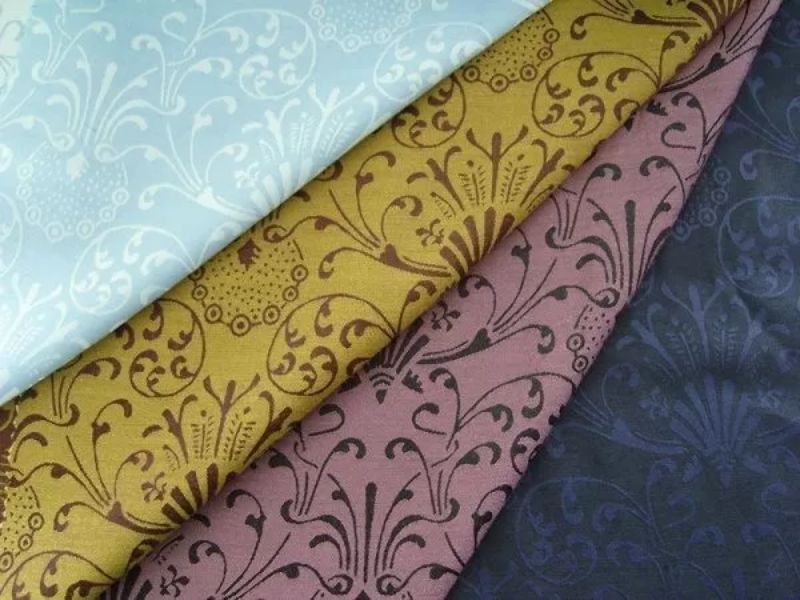
The development of Jacquard fabric is a historical and technological process that revolutionized the textile industry. Jacquard fabric is a special type of fabric that features intricate patterns and designs, created through the use of a mechanical loom known as the Jacquard loom.
The invention of the Jacquard loom can be attributed to Joseph-Marie Jacquard, a French weaver and inventor, who introduced this groundbreaking technology in the early 19th century. This innovation was a significant advancement from traditional hand weaving methods, as it provided a more efficient and precise way of producing complex patterns on fabric.
The Jacquard loom operates by utilizing a system of punch cards that control the movement of individual warp threads. These punch cards, featuring a series of holes and non-holes, determine which threads are lifted and which are lowered during the weaving process. By manipulating the arrangement of these cards, weavers can create intricate patterns and designs, producing fabrics of exceptional beauty and complexity.
The development of Jacquard fabric opened up new possibilities in the textile industry, allowing for the production of highly detailed and elaborate fabrics that were previously only achievable through time-consuming and labor-intensive hand weaving techniques. This advancement revolutionized the fashion and upholstery industries, as it made it easier and more cost-effective to produce fabrics with intricate and customized designs.
Today, Jacquard fabric is widely used in various applications, including clothing, upholstery, and home furnishings. Its versatility and aesthetic appeal make it a popular choice for designers and consumers alike. The development of the Jacquard loom and the subsequent production of Jacquard fabric represent a significant milestone in textile history, showcasing the power of innovation and technological advancements in shaping industries and changing the way we produce and appreciate fabrics.
In the past, creating Jacquard fabric was a labor-intensive and manual process. Weavers had to meticulously create the intricate patterns by hand, without the assistance of any machines. However, with the advancements in science and technology, specialized sewing machines have been developed specifically for sewing Jacquard fabric.
The introduction of these machines has revolutionized the fabric production industry. It has significantly reduced the cost of production, making Jacquard fabric more affordable and accessible to a wider range of consumers. As a result, the price of this luxurious fabric has also decreased, enabling more people to enjoy its elegance and beauty.
The first machine that was used to create Jacquard fabric was controlled by a mechanical system. It relied on punched cards as the main structure of operation. Nowadays, you can find various versions of this machine in the majority of sewing factories. These machines come in different designs to cater to the specific needs of fabric production.
The process of producing Jacquard fabric involves intricate weaving techniques.
Now, let’s delve into the detailed process of creating a plate. Specifically, we will focus on the process of making a Jacquard fabric plate. Please pay close attention as we walk through the steps involved in producing this intricate and beautiful piece.
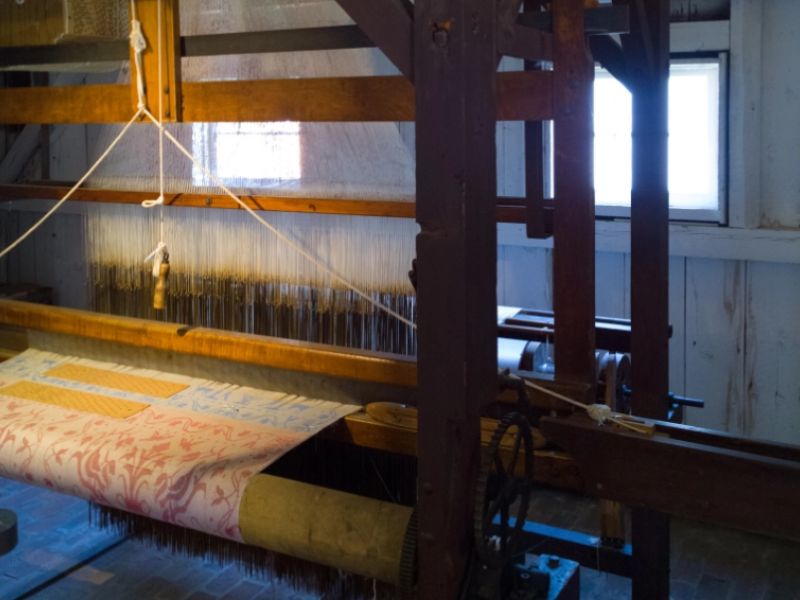
The Jacquard fabric production process involves several steps and techniques to create intricate patterns and designs on the fabric. It begins with selecting high-quality yarns that will be used to weave the fabric.
Once the yarns are chosen, they are dyed in various colors to achieve the desired design. The dyed yarns are then loaded onto a Jacquard loom, which is a special type of loom that allows for the creation of complex patterns.
The Jacquard loom is controlled by a computerized system that reads instructions from a digital file. These instructions dictate which yarns are raised and lowered during the weaving process. By selectively raising and lowering the yarns, the loom creates the desired pattern.
As the loom weaves the fabric, the Jacquard mechanism raises the appropriate yarns to create the pattern. The weft yarns are woven through the raised and lowered warp yarns to create the fabric.
Once the fabric is woven, it goes through a finishing process. This may involve washing, pressing, and treating the fabric to enhance its appearance and texture.
The final step in the Jacquard fabric production process is quality control. Each yard of fabric is thoroughly inspected to ensure that the pattern is accurate and the fabric meets the desired specifications.
Overall, the Jacquard fabric production process is a complex and intricate process that requires skilled artisans, high-quality materials, and precise machinery to create beautiful and unique fabrics.
Once the raw materials are fully purchased, they will be transported to the factory where they undergo a process to remove any natural impurities such as seeds and dirt. Next, the materials are subjected to rough drawing, which serves to increase their size while also enhancing the durability and toughness of the fabric fibers. The yarn tubes are then subjected to a warp sizing process, which involves the application of a sizing film around the fibers. This is achieved through the use of modified starch and artificial sizing agents such as polyacrylate and polyvinynalcol (PVA). The result of this process is that the fabric fibers become more durable, smooth, and shiny.
- Step 2: Coloring
Once the raw fibers have been spun, they undergo a natural bleaching process. Furthermore, the fibers are frequently subjected to treatments involving dyes and organic solutions, enhancing the fabric’s ability to retain color. Utilizing Jacquard weaving technology, craftsmen ensure that the fabric achieves optimal coloration. Simultaneously, they employ a washing technique that effectively removes any excess dye and leftover dirt.
After the fabric has been dyed, it will undergo the process of being placed into the Jacquard weaving machine. Here, the warp yarn and the weft yarn will be intricately intertwined to produce fabric that showcases stunning and intricate patterns. Subsequently, the craftsman will immerse these fabrics into chemical solutions and incorporate additives to enhance their quality. The pre-dyeing procedure plays a crucial role in augmenting the fabric’s color palette, resulting in a distinctive amalgamation of hues. Moreover, this technique allows the craftsman to weave the fabric more efficiently, especially when working with a wide array of colors.
- Step 4: Complete the product
After the weaving process is completed, the Jacquard fabric will go through a meticulous inspection to guarantee uniform quality and address any remaining errors. Once this inspection is carried out, the fabric will be finished and packaged accordingly. Subsequently, it will be transferred to either the design stage or the purchasing unit, depending on the intended purpose.
Pros and cons of Jacquard fabric
Jacquard fabric is a specialized type of fabric that offers both advantages and disadvantages. The following information will provide a deeper understanding of its characteristics.
Advantages:
1. Versatility: Jacquard fabric allows for intricate patterns and designs to be woven directly into the fabric, offering endless possibilities for creativity and customization.
2. Durability: The weaving technique used in Jacquard fabric results in a strong and durable material that can withstand regular wear and tear.
3. Texture: With its unique weaving structure, Jacquard fabric often has a textured surface, adding depth and visual interest to garments or furnishings made from this fabric.
4. Breathability: Jacquard fabric is typically made from natural fibers such as cotton or silk, which allows for better airflow and breathability, making it comfortable to wear in warm weather.
Disadvantages:
1. Cost: The intricate weaving process used in Jacquard fabric requires more time and attention to detail, making it more expensive than other types of fabrics.
2. Care: Due to its delicate nature, Jacquard fabric often requires special care when it comes to washing and maintaining. It may need to be hand-washed or dry-cleaned, which can be time-consuming and costly.
3. Limited Stretch: Unlike some other fabrics, Jacquard fabric typically has limited stretch, which may affect the fit and comfort of garments made from this material.
4. Availability: Jacquard fabric is not as widely available as other fabrics, making it harder to find and potentially limiting the options for projects or designs.
In summary, Jacquard fabric offers versatility, durability, texture, and breathability. However, it also comes with a higher cost, requires special care, has limited stretch, and may be less readily available.
Advantages of Jacquard fabric
- Durable: Jacquard fabric material highly appreciated by fashionistas for its durability, especially Cotton Jacquard. Even if you use it for a long time, you don’t have to worry about the fabric being deformed, stretched or faded. Most products made from this fabric have a very long life.
- Good elasticity: The structure of the very strong fibers combined with the Jacquard weaving method has created fabrics with good elasticity. Products from Jacquard fabric Keeps shape for a long time, does not wrinkle after use, clean, saves ironing time.
- High aesthetics: This type of fabric brings luxury, elegance and class to the wearer because of the unique patterns woven directly onto the fabric surface. Each piece of fabric shows the meticulousness and sophistication of the craftsman, so it is very popular in the high-end fashion industry.
- Various colors: Jacquard has an extremely diverse color collection, consumers can freely choose patterns and colors to suit their preferences and personal style.
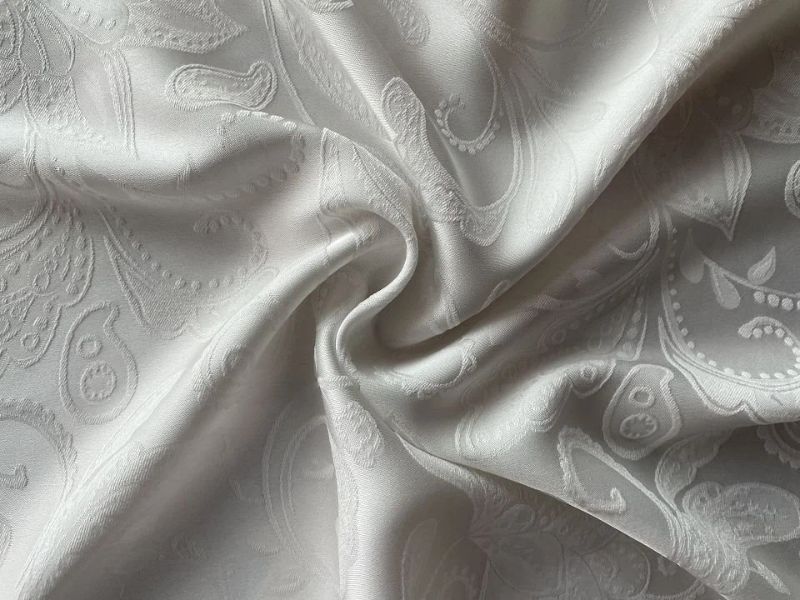
There are several advantages associated with Jacquard fabric. The fabric is known for its intricate designs and patterns, which are woven directly into the fabric. This creates a rich and luxurious appearance. Additionally, Jacquard fabric is highly durable and is resistant to wear and tear. It also has a good drape and is often used for drapery and upholstery purposes. The fabric has a soft texture and is comfortable to wear. It is also highly versatile and can be used for a wide range of applications, including clothing, home decor, and even industrial uses. Overall, Jacquard fabric offers a combination of aesthetic appeal, durability, versatility, and comfort.
Drawbacks of Jacquard fabric include higher cost, complexity in production, and potential for snagging or fraying.
- High product cost: Although the price of this fabric has decreased thanks to Jacquard weaving technology, compared to other woven fabrics, it is still very expensive because of its complexity and sophistication.
- Difficult to preserve: If you use strong detergents or expose them directly to sunlight for a long time, iron them at temperatures > 30 degrees Celsius, the life of the fabric will decrease rapidly. Even some types of Jacquard fabric still fluffed after a period of use.
- Design limitations: Due to the thick fabric, the design is quite difficult. In addition, this type of fabric is quite hot and stuffy, so it is also limited in the production of different types of clothing.
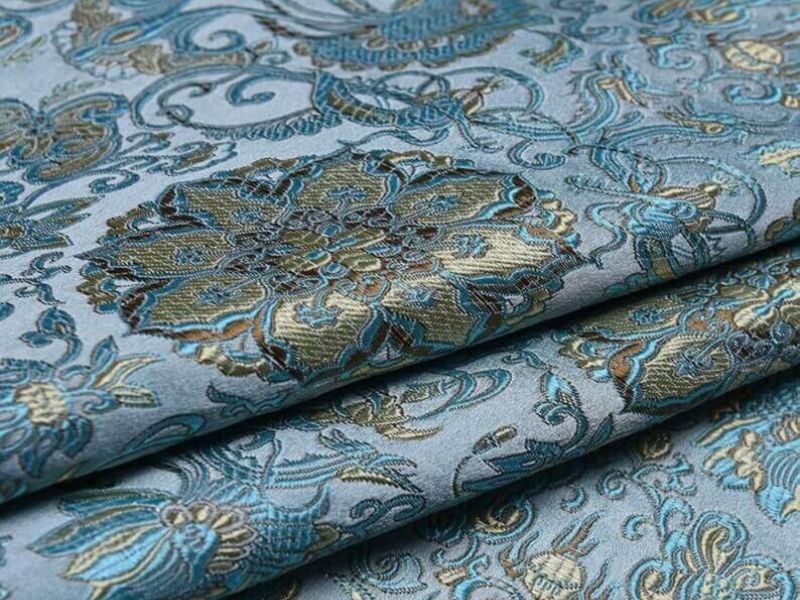
There are several disadvantages associated with Jacquard fabric.
Ways Jacquard fabric is used in everyday life
There are numerous popular applications of Jacquard fabric in our daily lives. Jacquard fabric is widely used in the fashion industry for designing and creating elegant garments such as dresses, suits, and blouses. Its intricate patterns and unique texture enhance the overall aesthetic appeal of these clothing items.
Moreover, Jacquard fabric is also extensively utilized in the production of home furnishings. It is commonly used for creating luxurious drapes, curtains, and upholstery. The beautiful designs and rich textures of Jacquard fabric add a touch of elegance and sophistication to interior spaces.
Additionally, Jacquard fabric is widely embraced in the field of automotive manufacturing. It is employed for designing and producing high-quality car seat covers, headliners, and interior trimmings. The durability and comfort offered by Jacquard fabric make it an ideal choice for enhancing the interior aesthetics and user experience in vehicles.
Furthermore, Jacquard fabric is employed in the production of accessories like handbags, wallets, and shoes. Its intricate patterns and premium quality make these accessories more visually appealing and stylish.
In conclusion, the versatility of Jacquard fabric makes it suitable for a variety of applications in our daily lives. From fashion to home furnishings and automotive industry, Jacquard fabric adds beauty, style, and functionality to numerous products we use and interact with on a regular basis.
- In fashion apparel: Jacquard fabric with unique classic patterns is often used to sew traditional costumes, imbued with the culture of ethnic groups. This type of fabric also attracts many famous designers because of its luxury and elegance. Therefore, it is not difficult for us to see costumes made from this fabric on domestic and international fashion shows.
- In furniture manufacturing: This is the field that Jacquard fabric Very popular because of its beautiful patterns, a mix of traditional and modern, durable fabric, making the space more luxurious and classy.
- In bedding production: With the advantages of good absorbency, breathability, natural antibacterial ability,… this fabric is also used in the production of bedding.
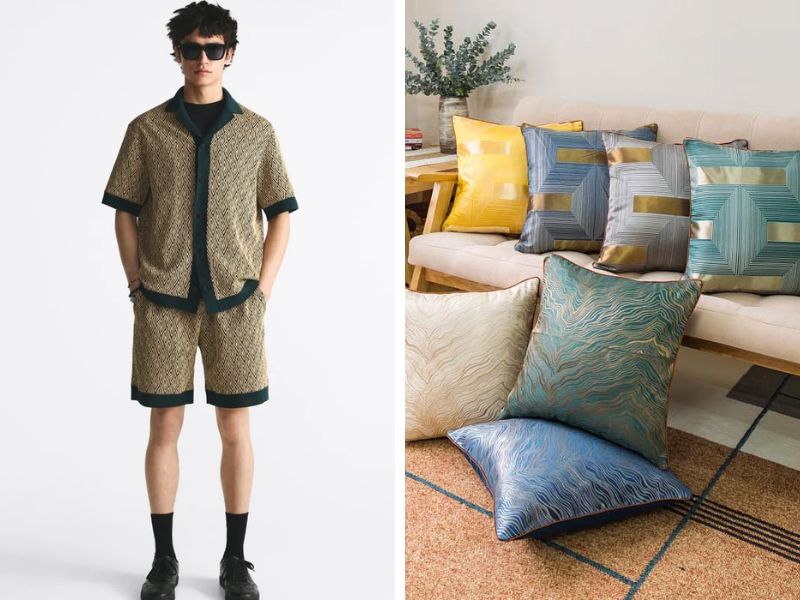
Jacquard fabric, renowned for its intricate patterns and versatility, finds numerous applications in our daily lives. This fabric is characterized by its unique weave structure, giving it the ability to create complex and detailed designs. Due to its aesthetic appeal and durability, Jacquard fabric is extensively used in various industries, including fashion, interior decoration, and upholstery.
In the fashion industry, Jacquard fabric is highly sought after for its luxurious appearance and ability to create eye-catching designs. It is widely used in the production of high-end clothing items such as dresses, suits, skirts, and blouses. The intricate patterns achieved through Jacquard weaving add a touch of elegance and uniqueness to these garments, making them stand out in the fashion world.
Furthermore, Jacquard fabric plays a pivotal role in interior decoration. It is commonly used for upholstery purposes, adorning furniture such as sofas, chairs, and cushions. The intricate designs and rich textures of Jacquard fabric enhance the aesthetics of any living or working space, adding a luxurious and sophisticated touch to the overall decor. This fabric is also utilized in the creation of curtains, drapes, and bedding, as it brings a sense of style and opulence to the room.
Apart from its fashion and interior design applications, Jacquard fabric is also utilized in various other everyday items. It is often found in bags, wallets, and accessories, as its durability ensures that these products are long-lasting. Additionally, Jacquard fabric is used in the manufacturing of towels, bathrobes, and other bathroom essentials, thanks to its absorbent nature and ability to withstand regular usage and washing.
In conclusion, Jacquard fabric is an integral part of our daily lives, finding its application in numerous industries and products. Its intricate patterns, durability, and luxurious appearance make it a favored choice in fashion, interior decoration, and everyday items. Whether adorning clothing, furniture, or household textiles, Jacquard fabric adds a touch of elegance and sophistication to our surroundings.
Follow these instructions to effectively clean and maintain Jacquard fabric for long-lasting preservation.
Please consult the cleaning and maintenance instructions for detailed guidance on caring for your item. Specifically for Jacquard fabric, it is important to follow the instructions below in order to ensure its longevity. Paying attention to these guidelines will help your item stay in good condition for an extended period of time.

Here are detailed instructions on how to effectively clean and preserve Jacquard fabric:
1. Determine the fabric content: Check the fabric label or consult the manufacturer’s instructions to identify the composition of the Jacquard fabric. This knowledge will help you choose the appropriate cleaning method.
2. Vacuum or brush: Start by removing any loose dirt, dust, or debris from the surface of the fabric using a vacuum cleaner with a soft brush attachment or a soft bristle brush. Be gentle to avoid damaging the delicate fibers.
3. Spot treatment: If there are any visible stains or spills on the fabric, treat them promptly. Blot the stain immediately using a clean, white cloth or paper towel. Avoid rubbing, as it can spread and embed the stain further into the fabric. Use a mild fabric cleaner or a mixture of water and mild detergent to gently blot the stain. Test any cleaning solution on an inconspicuous area first to ensure it doesn’t cause discoloration or damage.
4. Hand washing: If the Jacquard fabric is safe to hand wash, fill a basin with lukewarm water and add a small amount of gentle detergent. Submerge the fabric in the soapy water and gently agitate it for a few minutes. Do not wring or twist the fabric, as it can cause distortion or stretching. Rinse the fabric thoroughly with clean water until all the soap residue is removed.
5. Machine washing: If machine washing is recommended for the specific type of Jacquard fabric, use a gentle cycle and cold water. Place the fabric in a mesh laundry bag or pillowcase to protect it from getting tangled or stretched. Add a small amount of mild detergent suitable for delicate fabrics. Avoid using bleach or harsh chemicals, as they can damage the fabric. After the cycle is complete, remove the fabric promptly.
6. Drying: To dry Jacquard fabric, lay it flat on a clean towel or hang it on a padded hanger to avoid stretching. If using a towel, gently roll the fabric up inside it to remove excess moisture. Avoid wringing or twisting the fabric. Air drying is the best option for preserving the fabric’s integrity. Keep the fabric away from direct sunlight or heat sources, as they can cause color fading or shrinkage.
7. Ironing: If ironing is required, set the iron to a low or medium heat setting. Place a clean, white cloth over the fabric to protect it from direct contact with the iron. Gently press the iron over the cloth, avoiding any rubbing or pulling motions. If the fabric has a nap or textured pattern, iron it on the reverse side to prevent flattening or damaging the design.
8. Storing: When storing Jacquard fabric, make sure it is completely clean and dry to prevent mold or mildew growth. Fold the fabric neatly and place it in a breathable fabric bag or wrap it in a clean, white cotton sheet. Avoid using plastic bags or containers, as they can trap moisture and encourage damage. Store the fabric in a cool, dry place away from direct sunlight and humidity.
By following these detailed instructions, you can effectively clean and preserve your Jacquard fabric, ensuring its longevity and beauty.
- Prioritize hand washing, limit machine washing to avoid negative impacts on the product from the machine chamber.
- Wash the fabric at about 30 degrees Celsius to effectively clean dirt stains without damaging the fabric.
- Absolutely do not use strong detergents, especially with complex, detailed handmade products.
- If the fabric has metal attached, you should dry clean it to ensure the quality of the product.
- Dry clothes in a cool place, avoid drying in harsh sunlight.
- Avoid sharp objects piercing the fabric surface to avoid damaging the product.
The article on Fashion Bandung provides comprehensive information about Jacquard fabric. It covers various aspects such as the properties of this type of fabric, its classification, advantages and disadvantages, applications, cleaning methods, and preservation techniques. This detailed information aims to assist readers in making informed decisions when selecting products made from Jacquard fabric.
Fashion Bandung is a clothing brand that specializes in providing fashionable clothing options for men. The brand is dedicated to offering a wide range of stylish and trendy outfits that cater to the fashion needs and preferences of men. With a focus on quality and style, Fashion Bandung aims to provide men with clothing options that not only make them look good but also boost their confidence. Whether it’s formal wear, casual attire, or accessories, Fashion Bandung offers a diverse collection of men’s fashion that is designed to appeal to different tastes and occasions. From classic and timeless pieces to contemporary and cutting-edge designs, Fashion Bandung ensures that men have access to the latest fashion trends and styles. With its commitment to delivering high-quality garments that are both fashionable and comfortable, Fashion Bandung has become a popular choice for men who want to dress well and make a statement with their fashion choices.

